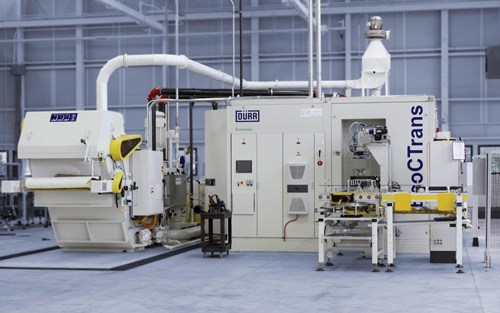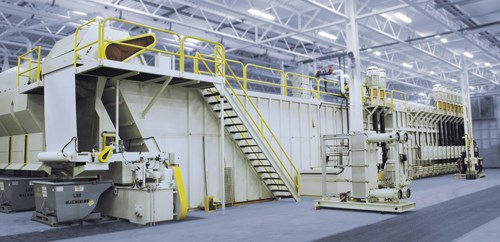When the world’s largest independent diesel engine maker needs to build a manufacturing system for the production of light-duty diesel engine blocks and cylinder heads for a new engine program, it often tends to think big.
So when Cummins Inc. began designing its new operations at its Columbus, Ind., plant, the company made the decision to not skip over the small details, which included making sure that its parts cleaning and deburring were just as sophisticated as its machining operations.
After bids came in for new systems for plant automation, parts cleaning and deburring, and centralized coolant filtration systems for the engine block and head production line, Cummins says it found a supplier with expertise in all three areas: Dürr Ecoclean.
Cummins says the system integration from
Dürr Ecoclean, Inc. helped keep its costs low and streamline the installation, minimizing the headaches associated with commissioning a new engine plant.
The 21st Century line
For its new plant, Cummins converted an older building that had formerly been used for production of an engine line and was taken out of service several years ago. The company planned a hybrid manufacturing process that would allow for incremental capacity increases in the production of these light duty diesel engine blocks.
Greg Langendorfer, Cummins’ LDD machining leader and project coordinator for the new plant, says his company needed this process to be robust in design while also allowing flexibility for the future.
He says Cummins wasn’t looking for one supplier, but after reviewing proposals it found that Dürr Ecoclean was able to offer all of the components needed for its flexible production line.
“Once we put together our list of potential suppliers, did our initial evaluations and put it up for competitive bids, we got our information back and evaluated it,” Langendorfer says. “And as it turned out, Dürr—with all its offerings—was selected as the supplier for all those components.”
Cummins asked Dürr Ecoclean to completely integrate the company’s existing CNC machines with its products—washers, coolant filtration systems, gantries, and robotic buffer systems, as well as conveyors and floor automation.
An integrated solution
Langendorfer says Cummins also chose Dürr Ecoclean because it had worked with the company in each of the three areas separately in other Cummins plants in the past.
“We worked with one individual for all three of Dürr’s products,” he says. “This gave us one point of contact for all our engineering work, our manufacturing work, equipment run-off, shipment, installation, and so on. All of that is being coordinated through one person. That was very significant, and it sure helped streamline the entire process.”
Cummins required an extensive solution for its automation process, consisting of a system of gantries and over-aisle elevators using Dürr’s modular Powered Zone Roller conveyor technology and a robotic buffer system to help manage part flow through the system.
Dürr says the PZR’s modularity also will enable possible future changes in plant layout and the addition of further machining centers to take place easily and quickly. The various “zones” of the PZR have their own bi-directional motors which only move components to the next zone when space is available. Since the motors do not run continuously as they do in conventional conveyors, the company says that both energy consumption and in-plant noise levels are reduced.
The conveying process also incorporates “overhead guided vehicles” to transport parts across main aisles without interrupting operator or forklift flow. “Robotic input-output” buffers help manage part flow through the process as this robotic pack-in, pack-out system permits automated short-term storage of components when a downstream operation is either blocked due to cycle times, or down for a tool change or machine refit. Therefore, when the downstream operation opens up again, the automated process takes place in reverse, feeding the blocks or heads back into production.
Cleaning parts with complex geometries
Cummins relies on two Dürr Ecoclean EcoCTrans parts cleaners for cleaning, deburring and drying applications for its diesel engine blocks and heads. The parts cleaners for the block washing applications feature a robust, solvent-based washing process with injection flooding and dedicated washing nozzles, as well as regenerative air blow-off and vacuum drying.
A cylinder block first enters an injection flood wash chamber for an initial immersion and rotating cleaning process, followed by two stages with dedicated washing nozzles directed at specific features, such as drilled tap holes or coupling features. This is followed by a drying process with a rollover and air blow-off, a regenerative air blow-off using heated air, and finally a vacuum drying station where the cylinder block is completely dried.
Cummins required a sophisticated system as part of its design specification for the cylinder head cleaning process. This cleaning process for the heads—performed by two additional EcoCTrans parts cleaners—is similar to that for the blocks, but with additional features and capabilities. The head final washer handles two heads at one time, and it automatically identifies them as being right or left cylinder heads by their features—no specific part number needs to be input by the operator.
In addition to the injection flood wash and dedicated wash stages, a third stage with high-pressure nozzles (4,500 psi) not only cleans, but deburrs surfaces and features as well. The cylinder heads also undergo air blow-off and vacuum drying processes similar to those for the engine block washing process.
Langendorfer says Cummins understood that the cylinder head would probably have the most potential for future proliferation, meaning that future requirements might mean there could be several different part numbers or machining configurations for different customers. A robot inside the parts cleaner can be programmed to accommodate different part numbers and address different features in terms of cleaning and deburring.
Success at project start-up
In addition to their satisfaction with having a single project manager to coordinate the planning for all three systems, Langendorfer and his colleagues at Cummins say they were pleased with the performance in the systems’ qualifying runs.
He says the robustness of the cleaning and filtration applications was perfectly suited for the large output of a major international player in engine production like Cummins. The design of Dürr Ecoclean’s automation systems gives Cummins smooth material flow for optimized production processes, while at the same time offering flexibility for future adaptations.
Cummins has purchased a number of washer and filtration systems from Dürr Ecoclean in the past. This latest project for Cummins is the first ever to include automation as well.
With the successful implementation of this integrated solution in its plant in Columbus, Ind., Langendorfer says Cummins and its worldwide subsidiaries have also opted to work with Dürr on similar projects in Russia and China, as well as on a new, highly automated and flexible engine production factory in Jamestown, N.Y., the most extensive project to date.n
For more information on Dürr Ecoclean USA, please call 248-560-2100 or email usa@ecoclean.durr.com.

.jpg;width=700;quality=80)





















